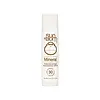What's inside
What's inside
 Key Ingredients
Key Ingredients

 Benefits
Benefits

 Concerns
Concerns

 Ingredients Side-by-side
Ingredients Side-by-side

Butyl Methoxydibenzoylmethane 3%
UV AbsorberHomosalate 5%
Skin ConditioningEthylhexyl Salicylate 5%
UV AbsorberOctocrylene 10%
UV AbsorberHydrogenated Polyisobutene
EmollientDiisostearyl Malate
EmollientCaprylic/Capric Triglyceride
MaskingButyloctyl Salicylate
Skin ConditioningC12-15 Alkyl Benzoate
AntimicrobialPolyurethane-79
Polyester-7
Skin ConditioningButyrospermum Parkii Butter
Skin ConditioningCocos Nucifera Oil
MaskingIsopropyl Palmitate
EmollientSesamum Indicum Seed Oil
EmollientNeopentyl Glycol Diheptanoate
EmollientDiethylhexyl Syringylidenemalonate
Skin ProtectingCaprylyl Glycol
EmollientGlycine Soja Oil
EmollientTocopherol
Antioxidant2-Methylbutyric Acid
PerfumingBarosma Betulina Leaf Oil
PerfumingBenzaldehyde
MaskingDimethylhydroxy Furanone
MaskingTrans-2-Hexenal
PerfumingHelianthus Annuus Seed Oil
EmollientEthyl Acetate
PerfumingStevioside
MaskingGamma-Undecalactone
PerfumingVanillin
MaskingVitis Vinifera Seed Extract
AntimicrobialLaminaria Ochroleuca Extract
Skin ConditioningCitric Acid
BufferingButyl Methoxydibenzoylmethane 3%, Homosalate 5%, Ethylhexyl Salicylate 5%, Octocrylene 10%, Hydrogenated Polyisobutene, Diisostearyl Malate, Caprylic/Capric Triglyceride, Butyloctyl Salicylate, C12-15 Alkyl Benzoate, Polyurethane-79, Polyester-7, Butyrospermum Parkii Butter, Cocos Nucifera Oil, Isopropyl Palmitate, Sesamum Indicum Seed Oil, Neopentyl Glycol Diheptanoate, Diethylhexyl Syringylidenemalonate, Caprylyl Glycol, Glycine Soja Oil, Tocopherol, 2-Methylbutyric Acid, Barosma Betulina Leaf Oil, Benzaldehyde, Dimethylhydroxy Furanone, Trans-2-Hexenal, Helianthus Annuus Seed Oil, Ethyl Acetate, Stevioside, Gamma-Undecalactone, Vanillin, Vitis Vinifera Seed Extract, Laminaria Ochroleuca Extract, Citric Acid
Zinc Oxide 8%
Cosmetic ColorantPrunus Amygdalus Dulcis Oil
Skin ConditioningSimmondsia Chinensis Seed Oil
EmollientButyrospermum Parkii Butter
Skin ConditioningCera Alba
EmollientEuphorbia Cerifera Wax
Argania Spinosa Kernel Oil
EmollientCaprylic/Capric Triglyceride
MaskingTocopheryl Acetate
AntioxidantCopernicia Cerifera Wax
Tocopherol
AntioxidantGlycine Soja Oil
EmollientGlyceryl Caprylate
EmollientBisabolol
MaskingPolyhydroxystearic Acid
EmulsifyingPolyglyceryl-3 Oleate
EmulsifyingIsostearic Acid
CleansingLecithin
EmollientGlyceryl Undecylenate
EmollientZinc Oxide 8%, Prunus Amygdalus Dulcis Oil, Simmondsia Chinensis Seed Oil, Butyrospermum Parkii Butter, Cera Alba, Euphorbia Cerifera Wax, Argania Spinosa Kernel Oil, Caprylic/Capric Triglyceride, Tocopheryl Acetate, Copernicia Cerifera Wax, Tocopherol, Glycine Soja Oil, Glyceryl Caprylate, Bisabolol, Polyhydroxystearic Acid, Polyglyceryl-3 Oleate, Isostearic Acid, Lecithin, Glyceryl Undecylenate
 Reviews
Reviews

Ingredients Explained
These ingredients are found in both products.
Ingredients higher up in an ingredient list are typically present in a larger amount.
This ingredient is also known as shea butter. It is an effective skin hydrator and emollient.
Emollients help soothe and soften your skin. It does this by creating a protective film on your skin. This barrier helps trap moisture and keeps your skin hydrated. Emollients may be effective at treating dry or itchy skin.
Shea butter is rich in antioxidants. Antioxidants help fight free-radicals, or molecules that may harm the body. It is also full of fatty acids including stearic acid and linoleic acid. These acids help replenish the skin and keep skin moisturized.
While Shea Butter has an SPF rating of about 3-4, it is not a sunscreen replacement.
Shea butter may not be fungal acne safe. We recommend speaking with a professional if you have any concerns.
Learn more about Butyrospermum Parkii ButterThis ingredient is an emollient, solvent, and texture enhancer. It is considered a skin-softener by helping the skin prevent moisture loss.
It helps thicken a product's formula and makes it easier to spread by dissolving clumping compounds.
Caprylic Triglyceride is made by combining glycerin with coconut oil, forming a clear liquid.
While there is an assumption Caprylic Triglyceride can clog pores due to it being derived from coconut oil, there is no research supporting this.
Learn more about Caprylic/Capric TriglycerideGlycine Soja Oil comes from the soybean. Glycine Soja is native to eastern Asia.
Soybean oil is an emollient. It is rich in antioxidants and fatty acids including palmitic, stearic, oleic, and linoleic acids.
As an emollient, the fatty acids in soybean oil helps keep your skin soft and hydrated. It does so by creating a film on top that traps moisture in.
Soybean oil is also rich in vitamin E, a potent antioxidant. Vitamin E is also anti-inflammatory and provides a soothing effect.
Studies show soy may help fade hyperpigmentation from UVB. It does so by disrupting the melanin process from UVB induced skin inflammation.
This ingredient may not be malassezia folliculitis, or fungal-acne, safe.
Soybeans are rich in proteins and are part of the legume family. Foods made with soybeans include tofu, soymilk, edamame, miso, and soy sauce.
Learn more about Glycine Soja OilTocopherol (also known as Vitamin E) is a common antioxidant used to help protect the skin from free-radicals and strengthen the skin barrier. It's also fat soluble - this means our skin is great at absorbing it.
Vitamin E also helps keep your natural skin lipids healthy. Your lipid skin barrier naturally consists of lipids, ceramides, and fatty acids. Vitamin E offers extra protection for your skin’s lipid barrier, keeping your skin healthy and nourished.
Another benefit is a bit of UV protection. Vitamin E helps reduce the damage caused by UVB rays. (It should not replace your sunscreen). Combining it with Vitamin C can decrease sunburned cells and hyperpigmentation after UV exposure.
You might have noticed Vitamin E + C often paired together. This is because it is great at stabilizing Vitamin C. Using the two together helps increase the effectiveness of both ingredients.
There are often claims that Vitamin E can reduce/prevent scarring, but these claims haven't been confirmed by scientific research.
Learn more about Tocopherol